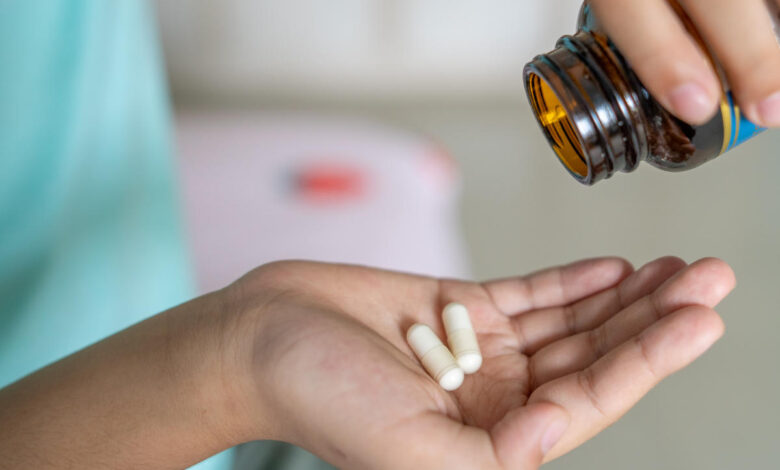Melatonin bottles are easy for young kids to open. New guidelines could change that.

After thousands of children wound up in U.S. emergency rooms after accidentally ingesting melatonin, a major supplement industry group has issued new safety guidelines, which include asking makers of the popular sleep aid to use child-deterrent packaging. Melatonin is generally considered safe for adults to use, but recent research has raised concern that it may be overused for children. And the spike in ER visits suggests that kids are taking it accidentally or without their parents’ guidance, sometimes leading to melatonin poisoning. Here’s what you need to know about melatonin safety and the new guidelines.
What is melatonin?
Melatonin is a hormone that the human body naturally produces to help maintain the sleep-wake cycle, or circadian rhythms, according to Mayo Clinic. Our bodies churn out melatonin in response to darkness, helping us fall asleep at night. Melatonin levels subside when it begins to get light out, helping us wake from sleep. Nighttime light — from indoor lighting, city light pollution or screens — reduces the normal evening increase in melatonin, potentially disrupting sleep, National Institutes of Health research suggests.
A synthetic version of the hormone can also be made in labs and taken as a supplement in capsule or gummy form and may help people with certain conditions fall asleep more easily. It’s considered safe to take on a short-term basis by the NIH, but supplements are not regulated by the Food and Drug Administration, so the agency warns to be careful when buying them.
Can you overdose on melatonin?
It’s extremely unlikely to have a life-threatening overdose from taking melatonin, but you can take enough to feel unwell, according to the Sleep Foundation. Symptoms include:
What are the signs of melatonin overdose in children?
Kids are particularly at risk for taking too much melatonin. Because the FDA doesn’t regulate supplements, there’s no recommended dose of melatonin for either adults or children, but kids — especially young ones — are less likely to know or read how much is too much. The dosage can also be unpredictable. “Over-the-counter melatonin supplements, when studied, showed varying dosage amounts in the same bottle, creating an overdose situation for many,” Dr. Nilong Vyas, a pediatrician and sleep coach in private practice, tells Yahoo Life. Children’s overdose symptoms are similar to adults’ and may include:
-
Upset stomach
-
Vomiting
-
Diarrhea
-
Tiredness
“Children who have taken too high a dose of melatonin may find it hard to arouse in the morning and remain groggy during the day,” says Vyas. “Most importantly, it impacts the body’s natural negative feedback loop, which helps to regulate normal melatonin production. “
In extreme cases, taking too much melatonin can land kids in the ER. And it’s not particularly rare. An estimated 10,930 children under age 5 were seen in U.S. emergency rooms for accidentally ingesting melatonin between 2019 and 2022, according to a recent CDC report. And the number of ER visits for melatonin ingestion among babies and kids rose 420% between 2009 and 2020. The majority of kids got a hold of melatonin that had been packaged in bottles, suggesting they were either left open or were easy for a young child to open.
Most of the children didn’t need to be hospitalized, but experts remain concerned about the risks of kids getting sick from having too much melatonin. In some cases, the supplements also contained more melatonin than their labels stated. In one April 2023 study, researchers found that one over-the-counter brand of melatonin gummies had more than four-times as much melatonin as its label said. Several contained both melatonin and CBD, but had far more CBD than their labels suggested.
Should kids take melatonin?
The American Academy of Pediatrics (AAP) says that melatonin can help get children on a new sleep routine and may be useful for some kids, such as those on the autism spectrum or with attention-deficit hyperactivity disorder (ADHD), but cautions parents to speak to their child’s pediatrician first.
It’s worth noting that there are possible risks. According to a previous CDC report: “Pediatric melatonin ingestions reported to U.S. poison control centers, including those requiring hospitalization and those with more serious outcomes, have increased during the past decade.” The concern stems more broadly from the extremely wide use of melatonin in children, and the lack of oversight over ingredients in the supplements. A study published earlier this year in JAMA Pediatrics found that nearly 1 in 5 school-aged children and preteens take melatonin, including more than 18% of kids between ages 5 and 9.
“The quick fix is to give your kid a pill to go to sleep,” Dr. Danelle Fisher, a pediatrician and chair of pediatrics at Providence Saint John’s Health Center in Santa Monica, Calif., previously told Yahoo Life.” Do most kids need that? No, they need sleep hygiene, and that’s tough. It’s much easier to take a pill.”
What do the new guidelines say?
After the CDC’s latest report was released, the supplement trade organization, the Council for Responsible Nutrition (CRN), called for melatonin manufacturers to limit the quantity of the synthetic hormone in their products. The guidelines ask manufacturers to stop loading their products with many times more melatonin than the 8 mg of melatonin most adults take or the 1 to 3 mg the NIH says is often used for children.
The guidelines also ask melatonin manufacturer’s to make their products’ containers harder for children to get into, in the hopes that will help to stem accidental ingestions. Finally, the CRN said that the supplement makers need to add labels to their packages to warn consumers that melatonin can cause drowsiness and should not be taken with alcohol.
Members of the organization have to comply within 18 months, or risk losing their membership. However, there is no legal requirement since the FDA doesn’t oversee supplements. Still, Vyas counts it as a win. “Creating guidelines on standardizing labeling, manufacturing and packaging is a significant first step in preventing long-term consequences,” she says.




